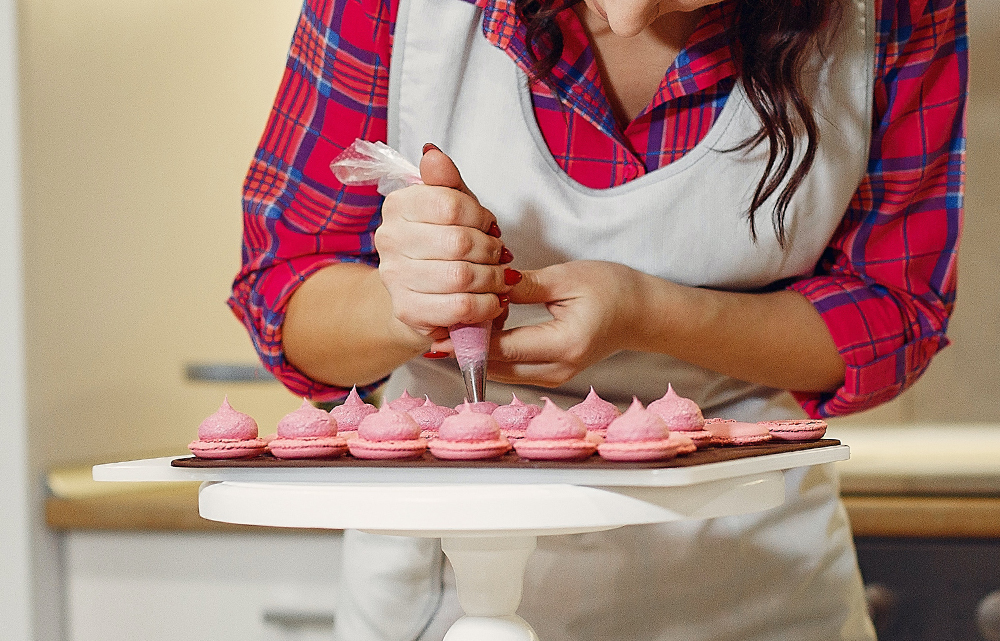It’s the little details that give your pastries that extra visual appeal. When executed correctly, rosettes of cream, kisses of ganache and handmade buttercream flowers easily take your sweet confection to another level.
You’ve probably already learned the basics of piping pastries while taking basic pastry courses–but what about for when you want to take your pastry skills to the next level and start piping pastries like a professional chef? Here are some tips on how to give your piping skills an extra boost.
The Icing
When making an icing for piping, choose a recipe that produces a smooth and stable icing such as a buttercream, Swiss meringue or royal icing. When whipping the icing, mix it only until it is combined and fluffy. Stay on the lookout for over whipping and over aerating the icing to avoid bubbles and breakages when you begin to pipe.
The Cake
Unless you want the icing to puddle and get absorbed by the cake (like a tres leches or a poke cake), make sure that your cakes are thoroughly cooled before piping on your icing.
The Bag
Nowadays, disposable piping bags or reusable silicone pastry bags are the popular choice among bakers. Cloth piping bags are not as common due to the tedious clean-up and the occasional leakage from the fabric. When filling up the bag, fold down the wide edges so you can easily fill up your bag from the bottom and make your way upward. If you have a hard time simultaneously holding and filling up the bag, you can rest the bag inside a tall glass or jar. Fill up the bag with icing half to three-fourths way only, to avoid overflow and so that you have enough space to grip the bag. Push the icing towards the tip with your bad with your fingers or a plastic pastry cutter or scraper to remove any air bubbles. Twist the top to keep the icing in place to make it easier to pipe out. You can always to a test pipe before you proceed to icing your cake.
The Tips
With so many different piping tips to choose from, the choice ultimately rests on what kind of design you would like to achieve for your finished product. The size of your tip and nozzle will also be dependent on how much icing you want to dispense and how large a pattern you want to create. For smooth edges, dots, lettering and circular designs, choose a round tip. For more defined edges, ruffles and shell-like dollops, use a star tip. Petal and leaf tips come in handy for edible flowers and creating borders, while specialty tips are available to make unique statements and patterns with your icing. When placing the tip inside your piping, particularly for a disposable piping bag, only cut enough of the plastic end for the piping nozzle to peek out one third or halfway through. You can also use a coupler if you plan on changing tips throughout your piping.
The Wrist
The key to consistent and beautiful piping without tiring out your hands is to utilise your wrist. After pushing all the icing towards the tip, place your dominant hand on the bag where the bulk of the icing ends and where you twisted the plastic. Use your other hand to keep your piping steady and to guide yourself as you press the icing out of the bag. For circular and spiral designs, hold the bag at a 90 degree angle and apply steady pressure on the bag to keep the icing in a continuous flow. When icing cakes and small cupcakes, begin piping from the edge and make your way towards the center, making use of your wrist moving in a concentric motion. Keep the bag at the same 90 degree angle when making vertical and perpendicular lines and patterns. For writing, making borders and icing the sides of a cake, tilt your bag into a 45 degree angle to achieve a more professional finish.
The Baker
Practice makes perfect. Stay calm and keep practicing. The more you practice, the more accustomed your hands and wrist will be to make smooth and flawless piped patterns like a pro. Keep up to date with different pastry trends and piping patterns.
If you are truly serious about getting better and building a rewarding career in the pastry arts, it may be a good idea to enrol in an advanced or a professional pastry arts certificate course, like Enderun Extension’s 8-month Professional Pastry and Bakery Arts program. After all, studying under world-renowned pastry chefs from École Ducasse Manila (formerly known as École Ducasse Philippines) can only be beneficial for those who are interested in a career in pastry arts either in the Philippines or abroad.

 menu
menu